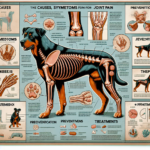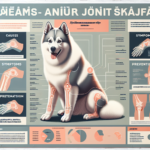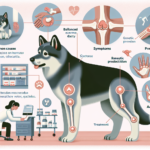Beauceron Joint Pain: Causes, Symptoms, Prevention, and Treatment

Introduction
The Beauceron, also known as the Berger de Beauce or Bas Rouge, is a French herding dog breed known for its intelligence, versatility, and loyalty. Originating from the plains of Northern France, the Beauceron has a rich history as a working dog, excelling in tasks such as herding, guarding, and even military work. Characterized by its muscular build, short coat, and distinctive double dewclaws on the hind legs, the Beauceron is a robust and agile breed. Despite its many strengths, the breed is not without its health concerns, one of the most significant being joint pain.
Joint health is a critical aspect of overall well-being for the Beauceron. Given their active lifestyle and working heritage, maintaining healthy joints is essential for their mobility and quality of life. Joint pain can severely impact a Beauceron’s ability to perform daily activities, making it crucial for owners to be aware of the causes, symptoms, prevention, and treatment options available.
Breed-Specific Joint Pain Risks
Genetic Predisposition
Like many large breeds, the Beauceron is genetically predisposed to several joint-related issues. Hip dysplasia, a condition where the hip joint doesn’t fit properly into the hip socket, is particularly common. This genetic disorder can lead to arthritis and significant pain over time. Elbow dysplasia, another hereditary condition, affects the elbow joint and can also result in chronic pain and lameness. Arthritis, a degenerative joint disease, is another concern, often developing as a secondary condition to dysplasia or due to the natural aging process.
Age-Related Risks
As Beaucerons age, the risk of developing joint pain increases. While younger dogs may show early signs of joint issues, such as mild limping or stiffness, these symptoms often become more pronounced as the dog reaches middle age. For Beaucerons, significant age milestones to watch for include the transition from puppyhood to adulthood (around 1-2 years) and the onset of senior years (around 7-8 years). During these periods, regular veterinary check-ups are essential to monitor joint health.
Activity Level and Joint Stress
The Beauceron is an active and energetic breed, often engaged in high-impact activities such as herding, agility, and obedience training. While their athleticism is one of their strengths, it can also contribute to joint stress. Repetitive motions, jumping, and running on hard surfaces can exacerbate existing joint issues or lead to new ones. Owners should be mindful of their dog’s activity level and provide appropriate rest and recovery periods to minimize joint stress.
Common Symptoms of Joint Pain in Beaucerons
General Symptoms
Joint pain in Beaucerons can manifest in various ways. Common symptoms include:
- Limping: A noticeable limp or favoring one leg over another.
- Stiffness: Difficulty getting up from a lying or sitting position.
- Reluctance to Move: Hesitation or refusal to engage in physical activities they once enjoyed.
- Swelling: Visible swelling around the joints.
- Behavioral Changes: Increased irritability or signs of discomfort when touched.
Breed-Specific Symptoms
In Beaucerons, joint pain may also present with breed-specific symptoms such as:
- Decreased Herding Ability: A decline in their natural herding instincts and abilities.
- Altered Gait: A noticeable change in their walking or running style, often appearing more rigid or uneven.
When to Consult a Vet
If you observe any of the above symptoms in your Beauceron, it is crucial to consult a veterinarian promptly. Early diagnosis and intervention can significantly improve the prognosis and quality of life for your dog. Regular veterinary check-ups are also essential for monitoring joint health, especially as your dog ages.
Preventive Measures for Joint Health
Exercise Recommendations
Maintaining an appropriate exercise regimen is vital for the joint health of Beaucerons. While they require regular physical activity to stay fit and healthy, it’s essential to balance high-impact exercises with low-impact activities. Recommended exercises include:
- Swimming: An excellent low-impact exercise that strengthens muscles without stressing the joints.
- Walking: Regular walks on soft surfaces like grass or dirt trails.
- Controlled Play: Engaging in controlled play sessions that avoid excessive jumping or abrupt stops.
Dietary Suggestions
A balanced diet rich in essential nutrients can support joint health. Consider incorporating the following into your Beauceron’s diet:
- Glucosamine and Chondroitin: Supplements that help maintain cartilage health.
- Omega-3 Fatty Acids: Found in fish oil, these can reduce inflammation and support joint health.
- Antioxidants: Foods rich in antioxidants, such as blueberries and spinach, can help reduce oxidative stress on joints.
Weight Management
Maintaining a healthy weight is crucial for reducing joint stress. Overweight dogs are at a higher risk of developing joint issues due to the additional strain on their joints. Regular exercise, portion control, and a balanced diet are essential for weight management. Consult your veterinarian for specific dietary guidelines tailored to your Beauceron’s needs.
Early Screening and Monitoring
Early screening and regular monitoring can help detect joint issues before they become severe. For Beaucerons, consider the following:
- Hip and Elbow Evaluations: Regular X-rays to assess joint health.
- Genetic Testing: Screening for genetic markers associated with joint disorders.
- Regular Check-Ups: Routine veterinary visits to monitor overall health and catch any early signs of joint issues.
Treatment Options for Joint Pain
Non-Surgical Treatments
Non-surgical treatments can effectively manage joint pain in Beaucerons. These include:
- Medications: Anti-inflammatory drugs and pain relievers prescribed by a veterinarian.
- Physical Therapy: Exercises and treatments designed to improve joint function and reduce pain.
- Lifestyle Adjustments: Modifying activity levels and incorporating rest periods to minimize joint stress.
Surgical Options
In severe cases, surgical intervention may be necessary. Common surgical options for joint pain include:
- Hip Replacement: Replacing the damaged hip joint with an artificial one.
- Arthroscopy: A minimally invasive procedure to remove damaged tissue or repair joints.
- Osteotomy: Cutting and realigning bones to improve joint function.
Alternative Therapies
Alternative therapies can complement traditional treatments and provide additional relief. These include:
- Acupuncture: Using needles to stimulate specific points on the body to relieve pain.
- Hydrotherapy: Water-based exercises that reduce joint stress while improving strength and mobility.
- Massage: Therapeutic massage to improve circulation and reduce muscle tension around the joints.
Lifestyle and Management Tips
Daily Care Routine
A consistent daily care routine can help manage joint pain in Beaucerons. Consider the following:
- Morning Walk: A gentle walk to start the day, avoiding hard surfaces.
- Balanced Diet: Providing meals rich in joint-supporting nutrients.
- Rest Periods: Ensuring your dog has ample time to rest and recover between activities.
- Evening Exercise: Low-impact activities like swimming or controlled play.
Modifying the Home Environment
Making your home more comfortable for a dog with joint pain can significantly improve their quality of life. Consider these modifications:
- Ramps: Installing ramps to help your dog navigate stairs or get onto furniture.
- Orthopedic Beds: Providing supportive bedding to reduce pressure on joints.
- Non-Slip Flooring: Using rugs or mats to prevent slipping on hard floors.
Long-Term Management
Long-term management strategies are essential for keeping your Beauceron active and happy despite joint pain. These include:
- Regular Vet Visits: Ongoing veterinary care to monitor and manage joint health.
- Consistent Exercise: Maintaining a balanced exercise routine tailored to your dog’s needs.
- Supportive Therapies: Incorporating physical therapy, hydrotherapy, or other supportive treatments as needed.
FAQs About Beaucerons and Joint Pain
What are the early signs of joint pain in Beaucerons?
Early signs of joint pain in Beaucerons include limping, stiffness, reluctance to move, and behavioral changes such as increased irritability.
Can joint pain in Beaucerons be prevented?
While genetic predispositions cannot be entirely prevented, maintaining a healthy weight, providing a balanced diet, and regular exercise can significantly reduce the risk of joint pain.
Are there specific exercises that are better for Beaucerons with joint pain?
Low-impact exercises such as swimming and controlled walking on soft surfaces are ideal for Beaucerons with joint pain.
What dietary supplements can help with joint health in Beaucerons?
Supplements such as glucosamine, chondroitin, and omega-3 fatty acids can support joint health in Beaucerons.
When should I consult a vet about my Beauceron’s joint pain?
If you notice any signs of joint pain, such as limping, stiffness, or reluctance to move, consult your veterinarian promptly for a thorough evaluation and appropriate treatment plan.
Conclusion
Joint pain is a significant concern for Beaucerons, given their active lifestyle and genetic predispositions. By understanding the causes, symptoms, preventive measures, and treatment options, owners can take proactive steps to ensure their dog’s joint health. Regular veterinary check-ups, a balanced diet, appropriate exercise, and early intervention are crucial for maintaining the well-being of this remarkable breed. By staying informed and vigilant, you can help your Beauceron lead a happy, active, and pain-free life.




